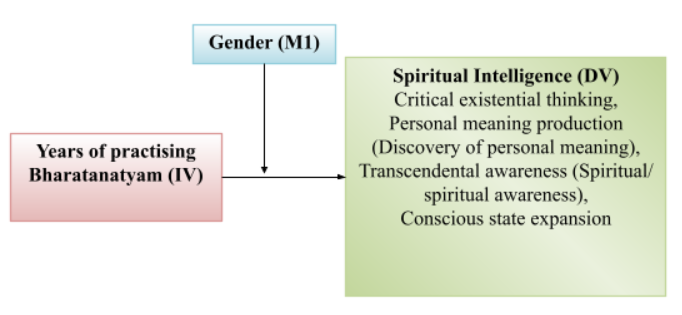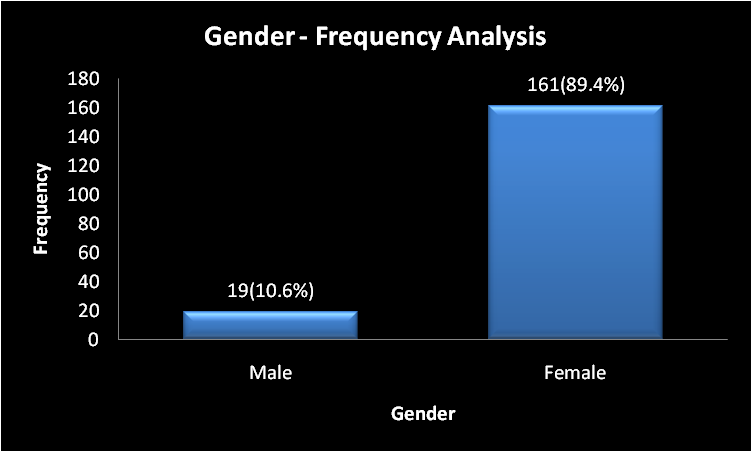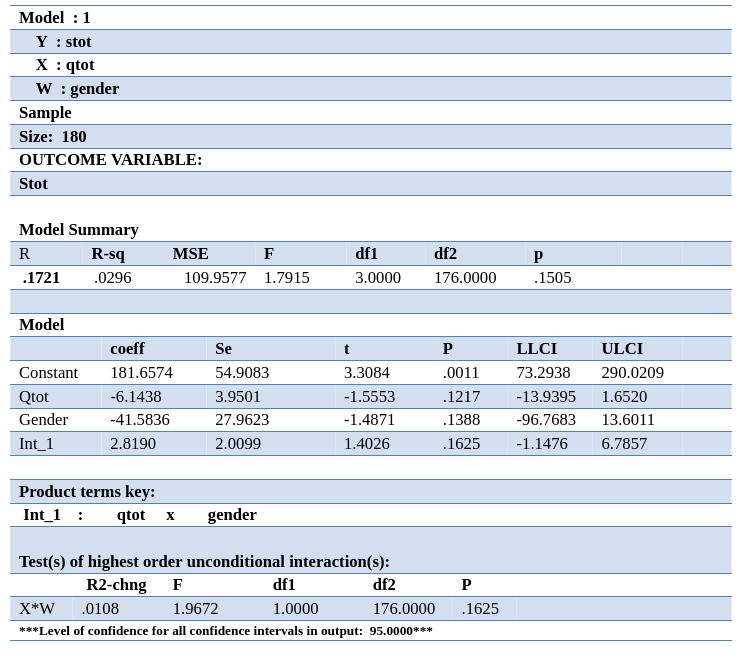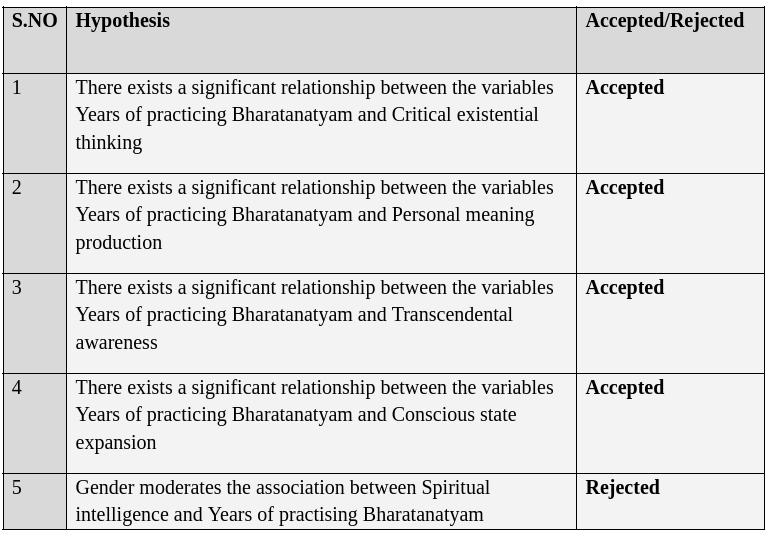UDC: 793.3(540) COBISS.SR-ID 59625225 CIP - 8 _________________
Received: Oct 28, 2021
Reviewed: Nov 03, 2021
Accepted: Nov 24, 2021
#4
An Empirical Research: Indian Classical Dance Education
And its Impact on The Students' Spiritual Intelligence
Kanaka Subramaniam
Research Scholar, School of Music and Fine Arts, Vels University, PV Vaithiyalingam Road,
Velan Nagar, Krishnapuram, Pallavaram, Chennai, Tamilnadu - 600 117, India
[email protected]
Sujatha Mohan
Professor and Head, Dr. MGR Janaki College of Arts and Science for Women, 11 & 13,
Durgabai Deshmukh Road, State Bank of India Colony,
Raja Annamalaipuram, Chennai,Tamilnadu- 600028, India
Research Scholar, School of Music and Fine Arts, Vels University, PV Vaithiyalingam Road,
Velan Nagar, Krishnapuram, Pallavaram, Chennai, Tamilnadu - 600 117, India
[email protected]
Sujatha Mohan
Professor and Head, Dr. MGR Janaki College of Arts and Science for Women, 11 & 13,
Durgabai Deshmukh Road, State Bank of India Colony,
Raja Annamalaipuram, Chennai,Tamilnadu- 600028, India
|
Citation: Subramaniam Kanaka, Sujatha Mohan. 2022. "An Empirical Research: Indian Classical Dance Education And its Impact on The Students' Spiritual Intelligence." Accelerando: Belgrade Journal of Music and Dance 7:4
|
Abstract
The aim of this study is to empirically investigate the impact that the period of learning of Indian Classical art form Bharatanatyam creates on the Spiritual intelligence of the students. Primary quantitative data has been collected using closed-end survey from 180 students pursuing Bharatanatyam from higher education institutions in India. The variable Spiritual Intelligence has been measured through 24 item SISRI scale. The moderating effect of the gender of the student has also been examined in this research. The statistical analysis of the primary data collected reveals that higher the years of learning of Bharatanatyam by an individual, higher is the level of Spiritual intelligence of the individual. It has also been revealed that out of the four constructs tested in this research to measure the variable Spiritual intelligence the construct critical existential thinking has greater significance when compared with that of the other three constructs namely transcendental awareness, conscious state expansion and personal meaning production. The study also reveals that gender does not moderate the relationship between Spiritual Intelligence and the number of years a person has been practicing and performing Bharatanatyam.
Keywords: Transcendental awareness, spiritual intelligence, Bharatanatyam, critical existential thinking, personal meaning, state of consciousness, gender. |
Introduction
The term Bharatanatyam could be split as “bhavam” which referred to expression, “ragam” that denotes music, “talam”, and “natyam”, that signifies dance. The dance that people now addresses Bharatanatyam is widely denotes as Sadir Natyam in the ancient period. Bharatnatyam is filled with spiritual values (Medhuri, 2005). Bharatanatyam is a meaningful dance form which uses various body parts, for example the eyes, hands, fingers and feet to emphasize different human emotions. Bharatanatyam prospered, since the dance form fix completely into the Chola Empire’s treasure system. The Chola Empire supported the Devadasi practice, and Devadasis were then as well recognized as DevarAdigalar. Other than being a skill form marked by attraction and refinement in its delivery (Rajkumar 2018), Bharatanatyam practice makes for an enthusiastic workout of the brain, mentality, body, and soul and ultimately spiritual values.
All Indian classical dances in general and Bharantnatyam in particular are generally a blend of body movements and expressions displayed on a dancer’s face; these are perfectly harmonized to denote a given perspective, through the flawless vehicle, that is, the human body. Though body and face seem connected with the dance and movements, it is inner soul of a human that directs his/her movements. Bharatnatyam is considered evolutionary art that induce the spiritual growth of the individual and ultimately bring in the Divine feeling. The God of dance, Lord Nataraja, is considered as the source of motivation for all Bharatanatyam dancers who comprehend the deeper portions of their art. Bharatanatyam is no less a religious exploration than the Sanyasi’s way of repudiation. Bhavnani and Bhavnani (2010) specified that Bhartnatyam dance helps its dancers to divinize themselves, to build spiritual quality, devotion, an act of Dharma, discipline, courage, skill, health, contentment and well-being and ultimately calmness. Spiritual Intelligence is a collective strength of supremacy, "since it makes the individual to rise above acquisitive aspects of their survival, it as well contributes to rebuild their individual growth. In Bharatanatyam, the divine consequence is of atma searching for unification with the paramatma." (Chatterjee 2013) Consequently "this feeling is impersonal joy quality of observation of the Supreme Self by the adept, an ecstasy that is completely without personal sensitivity or feeling." (Ibid.) Bharatnatyam and spirituality are interrelated with one another as its inspirations come from the ancient temple, i.e. Chidambaram. Dance itself regarded as a sanctified space, a medium to reach a higher empire, represents a commixing of the physical and spiritual which is a primary part of Indian cultures, values and philosophical systems. Bharatnatyam gives the spectators with an inimitable essence of a spiritual mixed with a modern broad-based flavor. Bharatnatyam shares its universal human emotions for example love, shyness, fear, amongst others. As pointed out by Katrak (2013) the historic revival of bharatanatyam laid emphasis on its spiritual rather than of its sensual elements. Indian classical dance can be an effective medium for modern spiritual value, understood to be separated from any particular religious association, and no longer reliant on convention, but established on a contemporary subjectivity and on the spectators’ agency and communication. The communicative performance place of the Indian shrines, as they subsist in the present day, could have an influence on the manifestation of spiritual values through traditional dance, without bringing up any plot of connection with pre-modern religious principles. Royo (2010) emphasized that Bharatnatyam as a dance contributing to a logical, artistic, emotional, and spiritual engagement. An aspect of spirituality could be articulated through Indian classical dance, i.e. Bharatnatyam. Indian classical dance can be an effective medium for modern spiritual value, understood to be separated from any particular religious association, and no longer reliant on convention, but established on a contemporary subjectivity and on the spectators’ agency and communication. The communicative performance place of the Indian shrines, as they subsist in the present day, could have an influence on the manifestation of spiritual values through traditional dance, without bringing up any plot of connection with pre-modern religious principles. Royo (2010) emphasized that Bharatnatyam as a dance contributing to a logical, artistic, emotional, and spiritual engagement. An aspect of spirituality could be articulated through Indian classical dance, i.e. Bharatnatyam. I
|
|
Table 4b From ANOVA (Table 4b), the p value is observed as lesser than 0.05 (p<0.0005) thus regression model substantially predicts outcomes reliably and ANOVA is significant. Table 4c
Table 4c estimates the relationship between YPB and the CES through hypothesis, ‘there exists a significant relationship between the variables Years-of-practicing Bharatanatyam and Personal meaning production’. Regression equation for estimating spiritual intelligence factor ‘personal meaning’ through practicing Bharatanatyam is analysed through:
YPB = 7.815 + (0.313 * PMP)
1.3.3 Years-of-practising Bharatanatyam (YPB) and Spiritual intelligence (SI) factor Transcendental awareness (TA):
The third hypothesis analyses the relationship of YPB and TA (Table 5a) where the values of R (.525), R^2 (.276) and adjusted R^2 (.272) are obtained, where the 27.6% of dependent variable is described by the independent variable. Table 5a Table 5b From ANOVA (Table 5b), the p value is observed as lesser than 0.05 (p<0.0005) thus regression model substantially predicts outcomes reliably and ANOVA is significant. Table 5c Table 5c estimates the relationship between YPB and the TA through hypothesis, ‘there exists a significant relationship between the variables Years-of-practicing Bharatanatyam and Transcendental awareness’. Regression equation for estimating spiritual intelligence factor ‘awareness’ through practicing Bharatanatyam is analysed through:
YPB = 10.265 + (0.462 * TA)
1.3.4 Years-of-practising Bharatanatyam (YPB) and Spiritual intelligence (SI) factor Conscious state thinking (CSE):
The fourth hypothesis analyses the relationship of YPB and CSE (refer table 6a) where the values of R (.349), R^2 (.122) and adjusted R^2 (.177) are obtained, where the 12.2% of dependent variable is described by the independent variable. Table 6a Table 6b From ANOVA (Table 6b), the p value is observed as lesser than 0.05 (p<0.0005) thus regression model substantially predicts outcomes reliably and ANOVA is significant. Table 6c Table 6c estimates the relationship between YPB and the CSE through hypothesis, ‘there exists a significant relationship between the variables Years-of-practicing Bharatanatyam and Conscious state expansion’. Regression equation for estimating spiritual intelligence factor ‘state expansion’ through practicing Bharatanatyam is analysed through:
YPB = 60.984 + (0.650 * CSE)
|
Table 7
Hayes process for gender as moderator
|
Inference: Thus through Table 7, the outcome is found as p=0.1625 (i.e. p>0.05) it is evident that there is no association between the tested hypothesis: years of practising Bharatanatyam and spiritual intelligence is moderated by gender. Thus hypothesis5 association between YPB and SI is moderated by gender is rejected.
VI
|
ReferenceS
|
This website is under Attribution-NonCommercial-NoDerivatives 4.0 International (CC BY-NC-ND 4.0)
Belgrade Center for Music and Dance is the publisher of Accelerando: BJMD
Belgrade Center for Music and Dance is the publisher of Accelerando: BJMD




















